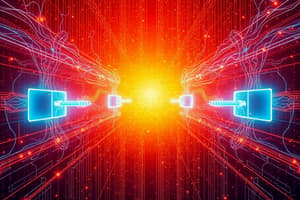Podcast
Questions and Answers
What does the BID field of a BPDU frame consist of?
What does the BID field of a BPDU frame consist of?
- Port priority
- Root bridge MAC address
- System ID Extension
- Bridge priority, Extended system ID, MAC address (correct)
Which spanning tree protocol uses perVLAN RSTP?
Which spanning tree protocol uses perVLAN RSTP?
- Rapid PVST+ (correct)
- PVST
- PVST+
- STP
What is the primary purpose of Extended System ID in PVST+?
What is the primary purpose of Extended System ID in PVST+?
- Determines the root bridge
- Unique BIDs for each VLAN (correct)
- Assigns port states
- Identifies the VLAN participating in STP
How many port states are used in PVST+ operation?
How many port states are used in PVST+ operation?
In root-bridge election manipulation, what action can lead to a switch becoming the root bridge?
In root-bridge election manipulation, what action can lead to a switch becoming the root bridge?
What type of BPDUs does RSTP use?
What type of BPDUs does RSTP use?
What issue at Layer 1 of the network can occur due to MAC database instability?
What issue at Layer 1 of the network can occur due to MAC database instability?
In the context of Spanning Tree Algorithm, what is the purpose of blocking redundant paths?
In the context of Spanning Tree Algorithm, what is the purpose of blocking redundant paths?
Which type of port in the Spanning Tree Algorithm is closest to the root bridge?
Which type of port in the Spanning Tree Algorithm is closest to the root bridge?
What is the purpose of the root bridge in STP?
What is the purpose of the root bridge in STP?
What happens when unknown unicast frames are sent onto a network with loops?
What happens when unknown unicast frames are sent onto a network with loops?
How does STP ensure only one logical path between all destinations on the network?
How does STP ensure only one logical path between all destinations on the network?
What determines the internal root path cost from a switch to the root bridge?
What determines the internal root path cost from a switch to the root bridge?
What information does each switch maintain locally regarding STP operation?
What information does each switch maintain locally regarding STP operation?
What is the default frequency of sending BPDU frames in STP?
What is the default frequency of sending BPDU frames in STP?
In STP, what role is automatically configured for all switch ports on the root bridge?
In STP, what role is automatically configured for all switch ports on the root bridge?
What role do alternate ports play in STP operation?
What role do alternate ports play in STP operation?
Flashcards are hidden until you start studying
Study Notes
Spanning Tree Concepts
- The switch with the lowest BID (Bridge ID) becomes the root bridge.
- Spanning Tree Algorithm determines the root bridge based on the root path cost.
STP Operation
- Root Path Cost: internal root path cost is determined by summing up individual port costs along the path from the switch to the root bridge.
- Custom cost can be applied using the spanning-tree cost value interface configuration command.
- The show spanning-tree command verifies the port and internal root path cost to the root bridge.
Port Role Decisions for RSTP
- Root bridge automatically configures all its switch ports in the designated role.
- Designated ports are configured for all LAN segments.
- The switch with the lower cost path to the root bridge has its port selected as the designated port.
- Alternate ports do not send or receive traffic on that segment.
802.1D BPDU Propagation and Process
- BPDU frames are sent every two seconds by default.
- Each switch maintains local information about its own BID, the root ID, and the root path cost.
Issues with Layer 1 Redundancy
- MAC Database Instability: no mechanism to block continued propagation of frames on a switched network.
- Broadcast Storms: a broadcast storm occurs when many broadcast frames consume all available bandwidth.
- Duplicate Unicast Frames: unknown unicast frames sent onto a looped network can result in duplicate frames arriving at the destination device.
Spanning Tree Algorithm
- Ensures only one logical path between all destinations on the network by intentionally blocking redundant paths.
- Port Roles:
- Root ports: ports closest to the root bridge.
- Designated ports: non-root ports permitted to forward traffic.
- Alternate and backup ports: blocking state to prevent loops.
- Disabled ports: a switch port that is shut down.
Root Bridge
- Serves as a reference point for all STP calculations.
- BID field of a BPDU frame consists of three separate fields:
- Bridge priority (default 32768).
- Extended system ID (identifies the VLAN participating in STP).
- MAC address (deciding factor when bridge priorities are equal).
Varieties of Spanning Tree Protocols
- Overview of PVST+: Cisco developed PVST+ to run an independent instance of IEEE 802.1D for each VLAN in the network.
- Port States and PVST+ Operation:
- Five port states: Blocking, Listening, Learning, Forwarding, and Disabled.
- Extended system ID ensures switches have unique BIDs for each VLAN.
- Rapid PVST+: the Cisco implementation of perVLAN RSTP, achieving faster convergence.
- Edge Ports: a switch port that is never intended to be connected to another switch.
Studying That Suits You
Use AI to generate personalized quizzes and flashcards to suit your learning preferences.




